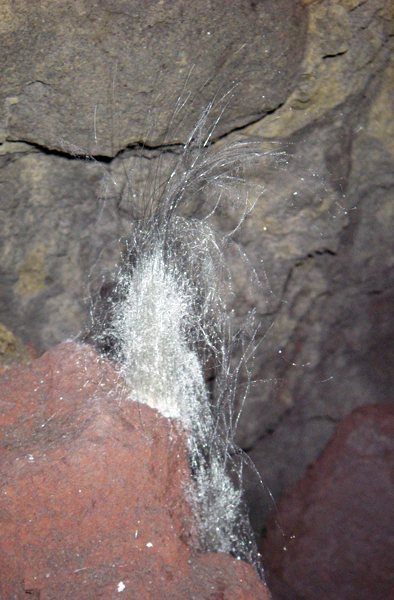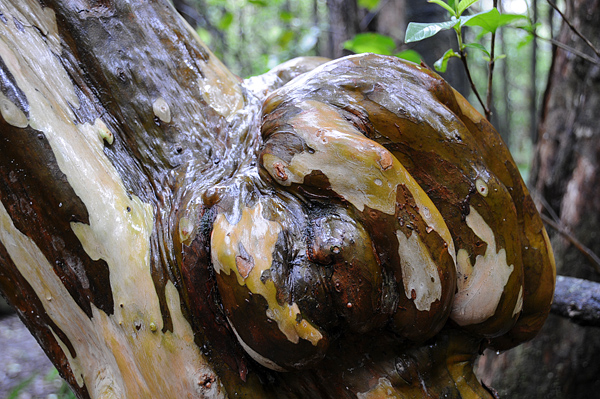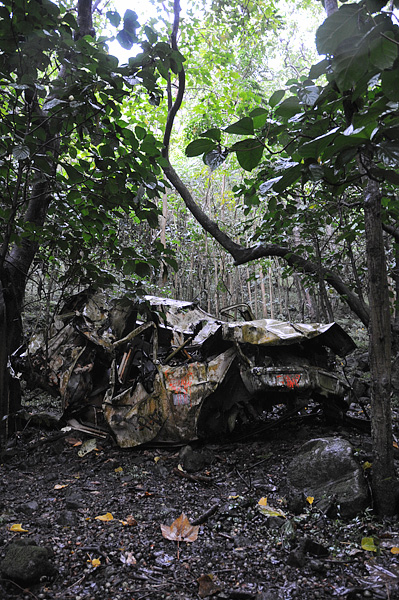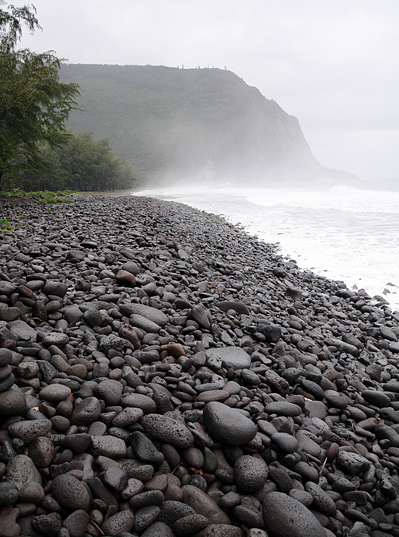Over a basic continental breakfast at Waimea’s Kamuela Inn, we had a very pleasant conversation with a nice native Hawaiian golf couple from Honolulu. Then it was off to the valleys and waterfalls of the northeast coast.
On the radio, the Civil Defense Authority warned of flash floods, and the north tip of the Big Island was the area being hit the worst. In some places, over 2 inches of rain per hourwere being recorded. We adjusted plans to get into areas that would have a lower likelihood of stranding us with washed-out roads, and headed east.
The Old Mamalahoa Highway was a bucolic drive through greener pasture land than was found on the west side, with undulating lava flow topography covered with rain-fed green grasses.
Midway along, we found an unmarked cave that we had read about. It was formed by a hollowed out network of connected lava tubes, creating an underground maze. Old generations of Hawaiians had formed small platforms within, and it was easy scrambling through the caves because all of the tubes had good headroom. The biggest issue was keeping our direction straight in the underground network, but we would have eventually found our way out by just walking around in circles if we ever needed to.
The crumbly pumice structure showed how lava tubes could form and drain, leaving behind these hollowed caves. The entrance was covered in small adapted ferns that took advantage of the diffuse light there, but back in the dark depths were only a few signs of life. Karen spotted a small albino white insect, and I found a most unusual “plant” formed of extremely delicate shiny filaments projecting up into the air 3 or 4 inches, creating an interwoven web pattern.
The one primary sign of modern disturbance was downright weird and difficult to explain: about 50 plastic bottles were piled under and on rocks in one particular chamber. They were all of different varieties and sizes. Most unusual, every single one of them was completely filled with water. It seemed as though a cave creature was devouring spelunkers before they even had a chance to take a sip from their bottles… or else it was an offering to the water thirsty cave monster by locals in the know. I left with both me and my bottle intact.
Further on past Honoka’a, we were the only hikers in Kalopa State Park, a 615 acre forest preserve that aimed to bring back a fully native forest to the area. Surrounded by the ecological devastation that has come to define Hawaii from its cattle ranches, agriculture, and development-based deforestation, the park is an oasis on its side of the mountains. There was nobody else on any of the trails our entire time there, so it was a beautiful and peaceful walk through forest that was re-establishing itself as native Hawaiian. Trees varied considerably, from several spongy-barked trees to the slick smooth-skinned remnants of common guava to the bizarre effects of the aggressive strangler fig that climbed up native trees and completely enveloped the original tree with new smothering trees. Amidst this, both nature and teams of volunteers had been fighting back over the past few decades, and the battle was gradually being won.
Honoka’a beckoned us back as we headed northwest. A small natural foods shack at the town entrance provided us with an excellent tasting non-meat tempeh-based “Superburger” and fruit smoothie. All good to power us up for the Waipi’o Valley hike ahead.
Waipi’o Valley was one of the quintessential hikes on the island’s north end, with verdant steep valley views at the ocean’s edge. To access the valley floor, a rudimentary mile long road descended straight down the volcanic rock side of the valley’s south side at an extremely steep 25% grade. It is supposedly the steepest county road in the entire United States. Only 4 wheel drive trucks are allowed down into it, and even those must be handled with care. A crumpled 2 wheel drive truck lies far below at the bottom of the road’s cliff edge, testament and warning to those who ignore the local knowledge.
For us, we hiked down the road, leaning back and letting our thighs burn all the way down. As rain splattered and ran a steady stream across the rough road surface, we saw moody gray views out over the valley and into the Pacific.
At the road’s end was a black crescent beach, surrounded to the north and south by sheer 900 foot cliffs. Local surfers bobbed in the large, well formed waves that shuddered onto lava rocks. Clouds and rain were visually inseparable in the gray lush weather.
We walked back up into the valley past a few remote homes of taro farmers, eccentrics, and people who really liked living in the rain, fording a river and exploring the small valley community. Above us on the sheer valley walls, two beautiful waterfalls were flowing at full volume. Hi’ilawe Falls cascaded 1450 feet from top to bottom, and dropped 1200 feet in one single straight fall to the valley floor.
We figured we’d likely be hiking out of the valley in the dark, but we hadn’t figured on dark torrential rain. The valley walls gradually faded grayer and grayer, until everything receded to the blackness of remote Hawaii. The slow slog out of Waipi’o eventually ended at our waiting car, where my Gore-Tex “protected” underwear squished and oozed out water as I sat in the driver’s seat. Karen stripped down to her underwear and rode that way all they way back to the inn; the car’s air was a lot drier than anything she was wearing.





Leave A Comment